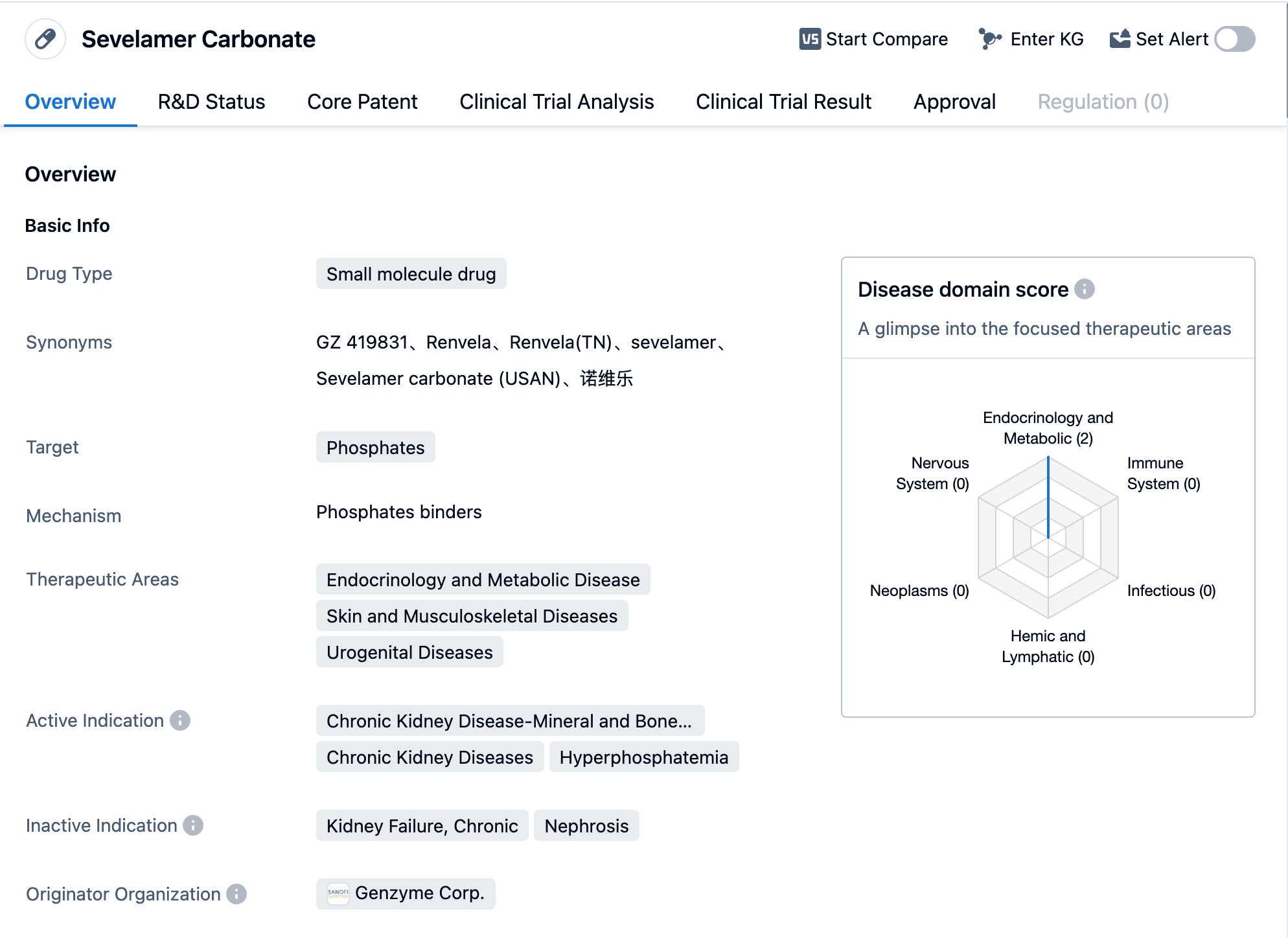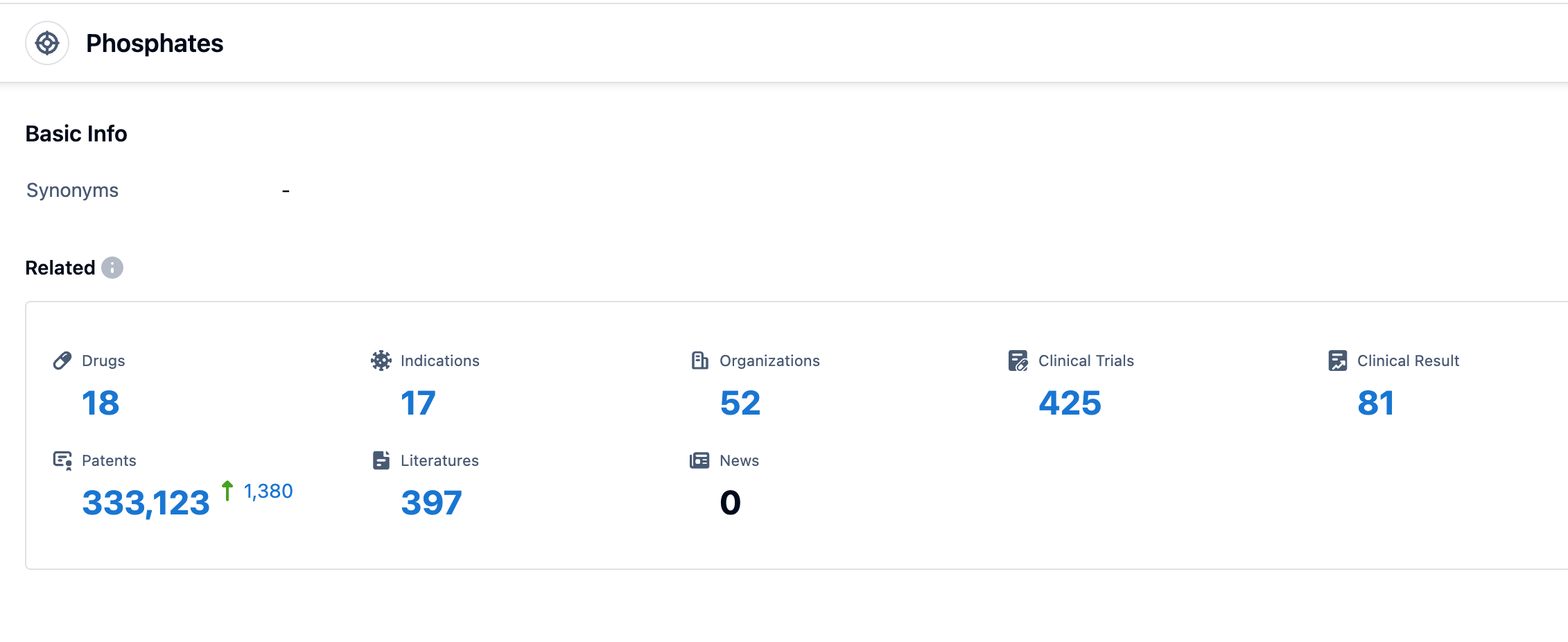Deep Scientific Insights on Sevelamer Carbonate's R&D Progress, Mechanism of Action, and Drug Targets
Sevelamer Carbonate's R&D Progress
Sevelamer Carbonate is a small-molecule drug that primarily targets phosphates in the body. It is used in the treatment of various conditions related to endocrinology and metabolic disease, skin and musculoskeletal diseases, and urogenital diseases. The drug is specifically indicated for chronic kidney disease-mineral and bone disorder, chronic kidney diseases, and hyperphosphatemia.
Sevelamer Carbonate was developed by Genzyme Corp., a pharmaceutical company specializing in biomedicine. It has reached the highest phase of development, with approvals in both the global market and China. The drug received its first approval in the European Union in June 2009.
The main therapeutic focus of Sevelamer Carbonate is on chronic kidney disease, particularly in managing the associated mineral and bone disorders. Chronic kidney disease is a progressive condition that affects the kidneys' ability to filter waste and excess fluids from the blood. This can lead to imbalances in minerals, such as phosphates, which can have detrimental effects on bone health.
👇Please click on the image below to directly access the latest data (R&D Status | Core Patent | Clinical Trial | Approval status in Global countries) of this drug.
By targeting phosphates, Sevelamer Carbonate helps to reduce their levels in the body, thereby addressing hyperphosphatemia, a common complication of chronic kidney disease. Hyperphosphatemia refers to abnormally high levels of phosphates in the blood, which can contribute to the development of mineral and bone disorders.
The approval of Sevelamer Carbonate in the global markets highlights its efficacy and safety in managing chronic kidney disease and associated complications. The drug's small molecule nature suggests that it is likely administered orally, making it convenient for patients.
Mechanism of Action for Sevelamer Carbonate: Phosphates binder
A phosphate binder is a medication or substance that helps to reduce the levels of phosphate in the body. Phosphates are naturally occurring compounds that contain phosphorus, an essential mineral for various biological processes. However, in certain medical conditions such as chronic kidney disease, the body may have difficulty eliminating excess phosphate, leading to high levels in the blood.
Phosphate binders work by binding to phosphate in the gastrointestinal tract, preventing its absorption into the bloodstream. This helps to lower the overall phosphate levels in the body. By controlling phosphate levels, phosphate binders can help prevent complications associated with high phosphate levels, such as mineral and bone disorders.
In a biomedical perspective, phosphate binders are commonly used in the management of chronic kidney disease and end-stage renal disease. They are often prescribed to patients undergoing dialysis, as their kidneys are unable to effectively remove excess phosphate. By reducing phosphate levels, these medications help maintain the balance of minerals in the body and prevent complications related to abnormal phosphate metabolism.
There are different types of phosphate binders available, including calcium-based binders, aluminum-based binders (less commonly used due to potential toxicity), and non-calcium, non-aluminum binders such as sevelamer and lanthanum carbonate. The choice of phosphate binder depends on various factors, including the patient's kidney function, calcium levels, and individual treatment goals. Regular monitoring of phosphate levels is necessary to adjust the dosage of phosphate binders and ensure optimal management of phosphate balance in the body.
Drug Target R&D Trends for Sevelamer Carbonate
The drug target of Sevelamer Carbonate is Phosphates. Phosphates play a crucial role in the human body as they are essential for various physiological processes. They are a major component of DNA, RNA, and ATP, which are vital for energy production and storage.
According to PatSnap Synapse, as of 30 Aug 2023, there are a total of 18 Phosphates drugs worldwide, from 52 organizations, covering 17 indications, and conducting 425 clinical trials.
👇Please click on the picture link below for free registration or login directly if you have freemium accounts, you can browse the latest research progress on drugs , indications, organizations, clinical trials, clinical results, and drug patents related to this target.
Based on the analysis of the data provided, it can be concluded that the target Phosphates in the pharmaceutical industry is experiencing significant growth and development. Companies such as Sanofi, CSL Ltd., and Fresenius Medical Care AG & Co. KGaA have shown the highest stage of development, with approved drugs in their portfolios. The most common indication for Phosphates drugs is hyperphosphatemia, followed by kidney failure, chronic, and chronic kidney diseases. Small molecule drugs are progressing most rapidly under the current targets, indicating intense competition in the market. The United States, Japan, the European Union, and China are the countries/locations developing fastest under the current targets, with China showing notable progress. Overall, the competitive landscape for target Phosphates is dynamic, and future development in this field holds great potential.
Conclusion
In summary, Sevelamer Carbonate is a small molecule drug developed by Genzyme Corp. It targets phosphates and is primarily used in the treatment of chronic kidney disease-mineral and bone disorders, chronic kidney diseases, and hyperphosphatemia. The drug has received approvals in the European Union and China, indicating its effectiveness in managing these conditions.






